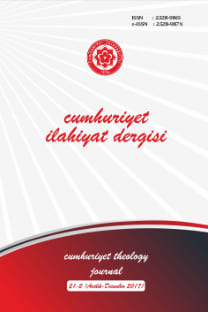Dini İnancın Temellerinin Bilimsel ve Teolojik Değerlendirmesi: Nöroteoloji
Din Eğitimi, Dini Gelişim, Nöroteoloji, Tanrı Geni, Tanrı Alanı, İnanç, Maneviyat.
Scientific and Theological Evaluation of Religious Belief: Neurotheology
Religious Education, Religious Development, Neurotheology, God Gene, God Module, Belief, Spirituality.,
___
- Alister Hardy. The Spiritual Nature of Man: Study of Contemporary Religious Experience. Oxford: Oxford University Press, 1979.
- Allport, Gordon W. The Individual and His Religion-A Psychological Interpretation. New York: The Macmillan Company, 1962.
- Azari, Nina P. - Slors, Marc. “From Brain Imaging Religious Experience to Explaining Religion: A Critique”. Archiv für Religionspsychologie 29 (2007), 67-86. https://doi.org/10.1163/008467207X188630
- Azari, Nina P. “Neuroimaging Studies of Religious Experience: A Critical Review”. Where God and Science Meet. ed. Patrick McMamara. 33-54. Westpost: Praeger Publishers, 2006.
- Barrett, Nathaniel F. “Principles of Neurotheology”. Ars Disputandi 11 (2011), 133-136. https://doi.org/10.1080/15665399.2011.10820062
- Bellous, Joyce E. vd. “A Child’s Concept of God”. Children’s Spirituality: Christian Perspectives, Research, and Application. ed. Donald Ratcliff. 201-218. Or: Cascade Books, 2004.
- Berger, Peter L. “Secularism in Retreat”. National Interest (Winter 1996), 3-12.
- Boyatzis, Chris J. “Religious and Spiritual Development in Childhood”. Handbook of the Psyc- hology of Religion and Spirituality. ed. Raymond F. Paloutzian - Crystal L. Park. 123- 143. London: The Guilford Press, 2005.
- Boyer, Pascal. “Religious Thought and Behaviour as By-Products of Brain Function”. Trends in Cognitive Science 7/3 (2003), 119-124. https://doi.org/10.1016/S1364- 6613(03)00031-7
- Çarkoğlu, Ali - Kalaycıoğlu, Ersin. “Türkiye’de Dindarlık: Uluslararası Bir Karşılaştırma”. Eri- şim 6 Şubat 2021. http://research.sabanciuniv.edu/14014/1/Rapor_Din- darl%C4%B1k.pdf
- D'Aquili, Eugene G. “The Neurobiological Bases of Myth and Concepts of Deity”. Zygon Journal of Religion and Science 13/4 (1978), 257-274. https://doi.org/10.1111/j.1467- 9744.1978.tb00338.x
- Dawkins, Richard. The Selfish Gene. Oxford: Oxford University Press, 1989.
- Forliti, John E. - Benson, Peter L. “Young Adolescents: A National Study”. Religious Education 81/2 (1986), 199-224. https://doi.org/10.1080/0034408600810206
- Freud, Sigmund, “Some Reflections on Schoolboy Psychology”. The Complete Psychological Works of Sigmund Freud, London: Hogarth Press and Institute for Psychoanalysis, 1914.
- Freud, Sigmund. Totem and Taboo. London: Hogarth Press, 1962 Gottlieb, Gilbert. “Probabilistic Epigenesis”. Developmental Science 10/1 (2007), 1-11. https://doi.org/10.1111/j.1467-7687.2007.00556.x
- Grangvist, Pehr. “Religiousness and Perceived Childhood Attachment: On the Question of Compensation or Correspondence”. Journal for the Scientific Study of Religion 37 (1998), 350-367. https://doi.org/10.2307/1387533
- Hamer, Dean. The God Gene. New York: Anchor Books, 2005. Heller, David. The Children’s God. Chicago: University of Chicago Press, 1988.
- Hood, Ralph W. vd. The Psychology of Religion: An Empirical Approach. New York: The Guil- ford Press, 2009.
- Hyde, Kenneth E. Religion in Childhood & Adolescence-A Comprehensive Review of the Rese- arch. Birmingham, Alabama: Religious Education Press, 1990.
- Klemm, William R. “Whither Neurotheology?”. Religions 10/11 (2019), 1-16. https://doi.org/10.3390/rel10110634
- Koenig, Harold G. Aging and God: Spiritual Pathways to Mental Health in Midlife and Later Years. New York: The Haworth Pastoral Press, 1994.
- Konda. “Hayat Tarzları”. Erişim 6 Şubat 2021. https://interaktif.konda.com.tr/tr/HayatTarz- lari2018/#7thPage/1 Köse, Ali. Freud ve Din. İstanbul: İz Yay., 2019.
- Köylü, Mustafa - Oruç, Cemil. Çocukluk Dönemi Din Eğitimi. Ankara: Nobel Yay., 2020.
- Langone, John. “In Search of the 'God Gene'”. The New York Times (Nov. 2) 2004.
- Mehmedoğlu, Ali Ulvi. İnanç Psikolojisine Giriş. İstanbul: Çamlıca Yay., 2013.
- Newberg, Andrew B. “Transformation of Brain Structure and Spiritual Experience”. The Oxford Handbook of Psychology and Spirituality. ed. L.J. Miller. 489-499. New York: Oxford University Press, 2012.
- Oser, Fritz K. vd. “Religious and Spiritual Development throughout the Life Span”. Handbook of Child Psychology- Volume I. Theoretical Models of Human Development. ed. R.M. Lerner. 942-998. New Jersey: John Wiley & Sons, Inc., 2006.
- Persinger, Michael A. - Makarec, Katherine. “Temporal Lobe Epileptic Signs and Correlative Behaviors Displayed by Normal Populations”. The Journal of General Psychology 114/2 (1987), 179-195. https://doi.org/10.1080/00221309.1987.9711068
- Persinger, Michael A. “Religious and Mystical Experiences as Artifacts of Temporal Lobe Func- tion: A General Hypothesis”. Perceptual and Motor Skills 57 (1983), 1255-1262. https://doi.org/10.2466/pms.1983.57.3f.1255
- Persinger, Michael A. Neuropsychological Bases of God Beliefs. Westport: Praeger, 1987.
- Rizzuto, Ana-Maria. The Birth of the Living God-A Psychoanalytic Study. Chicago: The Univer- sity of Chicago Press, 1979.
- Smith, Christian - Denton, Melinda Lundquist. Soul Searching: The Religious and Spiritual Li- ves of American Teenagers. New York: Oxford University Press, 2005.
- Spinella, Marcello - Wain, Omar. “The Neural Substrates of Moral, Religious, and Paranormal Beliefs”. Skeptical Inquirer 30/5 (2006), 117-135.
- Waller, Niels G. vd. “Genetic and Environmental Influences on Religious Interests, Attitudes, and Values: A Study of Twins Reared Apart and Together”. Psychological Science 1/2 (1990), 138-142. https://doi.org/10.1111/j.1467-9280.1990.tb00083.x
- Wulff, David M. Psychology of Religion-Classic and Contemporary Views. New York: John Wiley & Sons, 1991.
- Yazır, Elmalılı M. Hamdi. Hak Dini Kur’an Dili. İstanbul: Erkam Matbaacılık, 1992.
- Yocum, Russell. “Spiritual Development and Education: A Sequential Mixed-Methods Appro- ach”. Religion & Education 41/1 (2014), 80-99. https://doi.org/10.1080/15507394.2012.716351
- Zinnbauer, Brian J. - Pargament, Kenneth I. “Religiousness and Spiritually”. Handbook of the Psychology of Religion and Spirituality. ed. R.F. Paloutzian - C.L. Park. 21-42. London: The Guilford Press, 2005.
- Zinnbauer, Brian J. - Pargament, Kenneth I. “Working with the Sacred: Four Approaches to Religious and Spiritual Issues in Counseling”. Journal of Counseling and Development 78/2 (2000), 162-171. https://doi.org/10.1002/j.1556-6676.2000.tb02574.x
- ISSN: 2528-9861
- Yayın Aralığı: 2
- Başlangıç: 1996
- Yayıncı: Cumhuriyet Üniversitesi İlahiyat Fakültesi
Dini İnancın Temellerinin Bilimsel ve Teolojik Değerlendirmesi: Nöroteoloji
Göçtü Kervan: Türk Tasavvuf Şiirinde Kervan İstiaresi
Maneviyata Duyarlı Sosyal Hizmet
Afrika Arap Şiirinde Mukaddime Talaliyye (Batı Afrika Örneği)
Doketizm, Hz. İsa ve Kur’an: İslam Çarmıh Söylemini Doketizm’den mi Aldı?
Bir Öğretim Materyali Olarak Medya Haberlerinin Din Eğitiminde Kullanılması
Bir Bilgi Tanımının Eleştirisi: Devvânî’nin Risâle fî Ta‘rîfi’l-‘İlm Bağlamında
Din Antropolojisinde Ontolojiye Dönüş: Avrupa Merkezli Miras ile Yüzleşme
Pythagorasçı Felsefede Tekliğin İlkesi Olarak Külli Ruh: Monad
